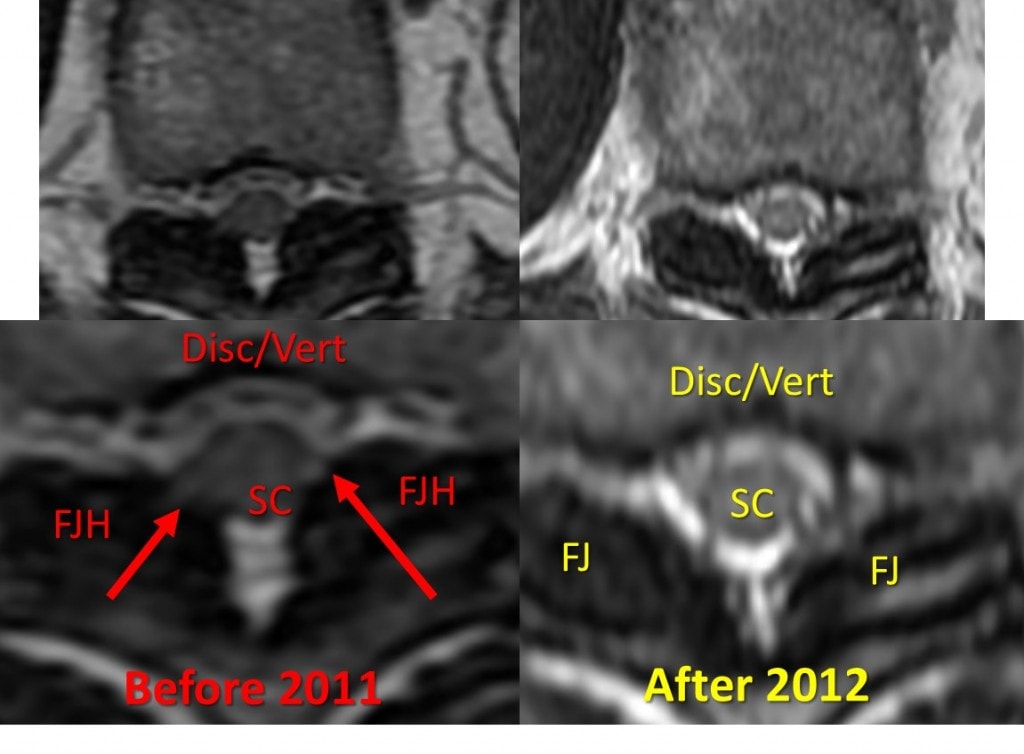Upper Back Surgery Procedures to Avoid
I always tell my patients that upper back surgery procedures are awful. If you happen to have a big herniated upper back disc pressing on your nerves and spinal cord or bony stenosis doing the same, an upper back surgery to remove the pressure is a much bigger and more invasive procedure than even low back surgery.
Why? Quite simply, the lungs are in the way. In most procedures they need to be deflated to give the surgeon enough room to operate, which means an instant ICU admission to re-inflate them. As a result, when this patient showed up last year with severe upper back pain, my goal was to see if we could help her avoid the procedure. Because she also had a stenosis component (bone spurs pressing on nerves), we used a procedure that we have been using for some time.
The Regenexx-DDD procedure was designed to address one of the major causes of degenerative disc disease (DDD), rather than just the symptoms. Believe it or not, bone spurs and enlarged joints pressing on nerves are a symptom of degenerative disc disease and not a cause. It’s been known since the 1960’s when Cloward introduced his neck fusion technique that bone spurs can go away once the extra motion associated with DDD is stopped. This is the reason we see so many fusion surgeries. The problem is that these spine fusion surgeries are quite invasive and fuse things solid, causing the levels above and below to move too much.
Is there a better way? This patient had the Regenexx-DDD procedure several times in 2011, treating both the irritated nerve through injecting her own growth factors into the epidural space as well as injecting those same growth factors into the surrounding ligaments to stabilize the area. She’s not completely finished with therapy and will need another round, but we checked an MRI this past week to check her spine. The MRI image above may take some explaining, but it documents a change not often seen in these patients. In the before image on the left note that SC=spinal cord and FJH=facet joint hypertrophy. In this case her facet joints (the joints that allow movement in the spine) are bigger than they should be (hence the term “hypertrophy”). Here they have grown big enough to press into the spinal canal (see the red arrows) and begin pressing on her thoracic spinal cord.
Why did they get that way? Our Orthopedics 2.0 book explains why. She has poor stability at this level, so it’s moving too much and her facet joints are reacting by getting bigger. What are the two major components of stability? Muscular and ligamentous. So to help her, we need to both tighten the ligaments and cause the muscles to get stronger. The Regenexx-DDD procedure involves injecting these ligaments with a growth factor mix that can help to make them stronger. In addition, it involves getting rid of the nerve irritation that’s shutting down the muscles so they can begin to work better as stabilizers. To do this, rather than injecting toxic steroids, we injected her own growth factors.
The result? Look now at the picture on the right. The big facet joints (now labeled with “FJ”) aren’t so big anymore and her spinal cord is now surrounded completely by a white color (this is the spinal fluid also called “CSF reserve”). Basically, her bony facet joint stenosis has improved. Is this something that usually waxes and wanes? No, not in my experience of reading tens of thousands of spine MRIs.
The upshot? Treating DDD is more than just injecting magic stem cells, you must treat the causes using an Orthopedics 2.0 approach!
NOTE: Regenexx-DDD is a medical procedure and like all medical procedures has a success and failure rate. Not all Regenexx-DDD patients experience this degree of improvement in their bony facet joint stenosis.

If you have questions or comments about this blog post, please email us at [email protected]
NOTE: This blog post provides general information to help the reader better understand regenerative medicine, musculoskeletal health, and related subjects. All content provided in this blog, website, or any linked materials, including text, graphics, images, patient profiles, outcomes, and information, are not intended and should not be considered or used as a substitute for medical advice, diagnosis, or treatment. Please always consult with a professional and certified healthcare provider to discuss if a treatment is right for you.

